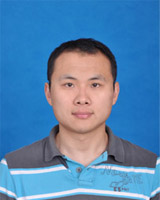Researchers Reveal the Secrete of Nonrandom DNA Seg-regation in Human Cells

Profile
Education:
02/2012-12/2016 Postdoc, Division of Nutritional Sciences, Cornell University
01/2008-06/2010 Postdoc, Dept. of Pathology, Zhejiang University School of Medicine
09/2002-12/2007 Zhejiang University School of Medicine Biochemistry and Molecular Biology
09/1997-07/2002 Binzhou Medical College Clinical Medicine
Academic appointments:
07/2010-01/2012 Instructor, Dept. of Public Health, Zhejiang University School of Medicine
01/2017-present Associate Prefessor, Dept. of Public Health, Zhejiang University School of Medicine
Research Interest:
I have committed myself for a long time to the study of protein translation during cellular stresses such as nutrients starvation and oxidative stress. My major achievements are: 1) Development of a method that maps start-codon positions and precisely measures the corresponding initiation rate on a genome-wide scale. Resultant initiation map highlights a dynamic range of translational initiation changes in response to nutrient starvation; 2) Revealment of post-initiation ribosome pausing as a signature of translation, which plays an important role in translation elongation during stress; 3) Identification of follistatin as a stress-responsive protein that promotes cancer cell survival under glucose-deprivation by inhibiting ribosome biogenesis and protein translation.
Awards:
2008-2010, China Post-Doctoral Fellowship
Research support:
National Natural Science Foundation of China Grant 81672847 (XG)
National Natural Science Foundation of China Grant 81472563 (XG)
National Natural Science Foundation of China Grant 30900235 (XG)
China Postdoctoral Science Foundation Grant 200902638 (XG)
Selected peer-reviewed publications:
[1] Zhang L, Han B, Xiang J, Liu K, Dong H, Gao X (Corresponding author). Silica nanoparticle releases SIRT6-induced epigenetic silencing of follistatin. Int J Biochem Cell Biol. 2018. 95:27-34.
[2] Zhang L, Liu K, Han B, Xu Z, Gao X (Corresponding author). The emerging role of follistatin under stresses and its implications in diseases. Gene. 2018. 639:111-6. (Review)
[3] Li S, Chen Y, Sun D, Bai R, Gao X, Yang Y, Sheng J, Xu Z. Angiogenin Prevents Progranulin A9D Mutation-Induced Neuronal-Like Cell Apoptosis Through Cleaving tRNAs into tiRNAs. Mol Neurobiol. 2018. 55(2):1338-51.
[4] Lin C, Zhao X, Sun D, Zhang L, Fang W, Zhu T, Wang Q, Liu B, Wei S, Chen G, Xu Z, Gao X (Corresponding author). Transcriptional activation of follistatin by Nrf2 protects pulmonary epithelial cells against silica nanoparticle-induced oxidative stress. Sci Rep. 2016. 6:21133.
[5] Zhou J, Wan J, Gao X, Zhang X, Jaffrey SR, Qian SB. Dynamic m(6)A mRNA methylation directs translational control of heat shock response. Nature. 2015. 526(7574):591-4.
[6] Zhang X, Gao X, Coots RA, Conn CS, Liu B, Qian SB. Translational control of the cytosolic stress response by mitochondrial ribosomal protein L18. Nat Struct Mol Biol. 22(5):404-10.
[7] Gao X, Wan J, Liu B, Ma M, Shen B, Qian SB. Quantitative profiling of initiating ribosomes in vivo. Nat Methods. 2015. 12(2):147-53.
[8] Gao X (Co-corresponding author), Dong H, Lin C, Sheng J, Zhang F, Su J, Xu Z. Reduction of AUF1-mediated follistatin mRNA decay during glucose starvation protects cells from apoptosis. Nucleic Acids Res. 2014. 42(16):10720-30.
[9] Han Y#, Gao X# (Co-first author), Liu B, Wan J, Zhang X, Qian SB. Ribosome profiling reveals sequence-independent post-initiation pausing as a signature of translation. Cell Res. 2014. 24(7):842-51.
[10] Ang J, Sheng J, Lai K, Wei S, and Gao X (Co-corresponding author). Identification of estrogen receptor-related receptor gamma as a direct transcriptional target of angiogenin. PLoS One. 2013. 8(8): e71487.
[11] Wang X, Hu G, Gao X, Wang Y, Zhang W, Harmon EY, Zhi X, Xu Z, Lennartz MR, Barroso M, Trebak M, Chen C, and Zhou J. The induction of yes-associated protein expression after arterial injury is crucial for smooth muscle phenotypic modulation and neointima formation. Arterioscler Thromb Vasc Biol. 2012. 32(11): 2662-9.
[12] Wei S, Gao X, Du J, Su J, and Xu Z. Angiogenin enhances cell migration by regulating stress fiber assembly and focal adhesion dynamics. PLoS One. 2011. 6(12): e28797.
[13] Gao X, Wei S, Lai K, Sheng J, Su J, Zhu J, Dong H, Hu H, and Xu Z. Nucleolar follistatin promotes cancer cell survival under glucose-deprived conditions through inhibiting cellular rRNA synthesis. J Biol Chem. 2010. 285(47): 36857-64.
[14] Qian J, Wang Y, Gao X, Zhan Q, Xu Z, and He S. Carboxyl-functionalized and bio-conjugated silica-coated quantum dots as targeting probes for cell imaging. J Nanosci Nanotechnol. 2010. 10(3): 1668-75.
[15] Qian J, Li X, Wei M, Gao X, Xu Z, and He S. Bio-molecule-conjugated fluorescent organically modified silica nanoparticles as optical probes for cancer cell imaging. Opt Express. 2008. 16(24): 19568-78.
[16] Gao X and Xu Z. Mechanisms of action of angiogenin. Acta Biochim Biophys Sin (Shanghai). 2008. 40(7): 619-24.
[17] Zhang H, Gao X, Weng C, and Xu Z. Interaction between angiogenin and fibulin 1: evidence and implication. Acta Biochim Biophys Sin (Shanghai). 2008. 40(5): 375-80.
[18] Gao X, Hu H, Zhu J, and Xu Z. Identification and characterization of follistatin as a novel angiogenin-binding protein. FEBS Lett. 2007. 581(28): 5505-10.
[19] Zeng Q, Ke X, Gao X, Fu Y, Lu D, Chiang H, and Xu Z. Noise magnetic fields abolish the gap junction intercellular communication suppression induced by 50 hz magnetic fields. Bioelectromagnetics. 2006. 27(4): 274-9.
[20] Hu H, Gao X, Sun Y, Zhou J, Yang M, and Xu Z. Alpha-actinin-2, a cytoskeletal protein, binds to angiogenin. Biochem Biophys Res Commun. 2005. 329(2): 661-7.

